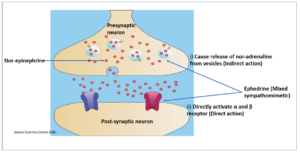- Ephedrine is an alkaloid obtained from plant of genus ephedra. It is non-catecholamine: sympathomimetic amine which doesn’t have catechol nucleus. Ephedrine was first isolated in 1885 and was commercially used in 1926. It is also available as generic medicine and is included in World Health Organization’s List of Essential medicines.
- It has long history of medicinal use in India and China to treat cold, fever, headache, coughing and other conditions. The herb containing ephedrine ‘ma huang’ is used in Chinese traditional medicine for more than 5000 years.
- It can be obtained by industrial synthesis, as a product of biotransformation or by extraction of the plant.
Mechanism of action of ephedrine

Figure 1- Mechanism of action of ephedrine
- It is a mixed acting sympathomimetic which mainly acts indirectly and enhances release of nor-adrenaline and dopamine from the sympathetic neurons and also acts as an agonist at both α and β receptor (direct action). It is taken up in neuron by NET (Nor Epinephrine Transporter) and get concentrated in vesicles by VMAT (Vesicular Monoamine Transporter). Thus, it displaces nor-adrenaline (NA) which gets released into synaptic cleft.
- It also inhibits reuptake of neurotransmitters like NA, dopamine and serotonin (5-HT) by membrane transporters.
Pharmacological action of ephedrine
Smooth Muscle
- It relaxes bronchial smooth muscle by stimulating β-2 adrenergic receptor. It causes relaxation of uterine smooth muscle.
Cardiovascular actions
- Ephedrine increases force of myocardial contraction and cardiac output.
- It causes increase in BP due to increase in cardiac output and peripheral vasoconstriction.
CNS
- It is a potent CNS stimulant. It acts on reticular activating system and stimulate CNS. In therapeutic doses, it can cause restlessness, insomnia, tremors and anxiety.
- It enhances monosynaptic and polysynaptic reflexes of the spinal cord and increases the depth and rate of respiration.
Eye
- When administered though local or systemic routes, it produces mydriasis.
Metabolic effects
- It increases metabolic rate and oxygen consumption.
Pharmacokinetics of ephedrine
- It is well absorbed from GI tract when given though oral route. After oral administration, its effect may persist for several hours. Ephedrine is also available in topical form as nasal drops or sprays.
- It is not affected by MAO (Mono-amine Oxidase) enzymes, hence have longer action than adrenaline. It has large volume of distribution and doesn’t bind to plasma proteins. Its free from have high tissue affinity and can penetrate into CNS.
- It is eliminated largely (60-70%) unchanged in urine. Some amount is metabolized in liver by deamination, demethylation, aromatic hydroxylation and conjugation.
- Its half-life is around 3-6 hours.
- It crosses placenta and is excreted in breast milk.
Therapeutic uses
- To treat chronic, persistent, moderate asthma and to prevent acute attack of asthma. It is replaced nowadays by more effective medications.
- Ephedrine drops can be used in nasal decongestion. It is used alone or in combination with other agents to relieve cold symptoms.
- It can be used during spinal anesthesia to treat frequently occurring hypotension.
- Used in Stokes-Adams syndrome to prevent ventricular asystole. Isoprenaline is preferred than ephedrine.
- It is used to produce mydriasis without cycloplegia.
- Used as CNS stimulant in narcolepsy and depressive states.
- It is also used in myasthenia gravis, nocturnal enuresis and whooping cough.
- Ephedrine can produce modest weight loss when used with exercise and low- fat diet. It became popular diabetic supplements in the early 1990s due to property like weight-loss and enhancer of athletic performance. However, due to various cardiovascular complications, its use for weight loss is not recommended nowadays.
Comparison with catecholamines
When compared with catecholamines, they are:
- Effective orally.
- Are not metabolized by MAO.
- Have longer duration of action.
- Crosses BBB and produce significant CNS effects.
Adverse Effects
- In therapeutic dose, it isn’t potentially toxic. When used in higher dosage, it can produce various adverse effects.
- It can cause life-threatening adverse cardiovascular complications like arrhythmia, hypertension and tachycardia.
- It can cause GI upset, difficulty in micturition, vomiting, headache, hypertension and palpitations. CNS symptoms may include nervousness, dizziness, delusion, hallucination and paranoid psychosis.
Note- Dietary supplements containing ephedrine were banned by FDA in 2004. Medications and supplements containing ephedrine and ephedra plants are still available in market, but the regulations may vary according to nation or state.
Drug Interaction
- It shouldn’t be taken together with drugs that cause irregular heartbeat. Such drugs include quinidine, procainamide, disopyramide and amiodarone.
- Concurrent administration with stimulant drugs like epinephrine, phenteramine and pseudopehdrine may cause increased heart rate and high blood pressure.
- It may interact with dexamethasone, ergot derivatives, MAO inhibitors, antidiabetics and anti-convulsant.
- Concurrent administration with beta-blocker may decrease effect of both drugs. Concurrent treatment with NSAIDs, ganglionic blocking agents and TCAs (Tricyclic anti-depressants) increase risk of hypertension.
- Urinary alkalinizers like sodium bicarbonate and acetazolamide prolong its action by reducing urinary excretion.
Contraindication
- It is contraindicated in patients with cardiovascular disease like hypertension, arrhythmia, angina pectoris.
- Contraindicated in patients with diabetes, glaucoma and hyperthyroidism.
- Contraindicated in patients with hypersensitivity to ephedrine or other sympathomimetics.
- It is contraindicated in psychoneurosis.
- Should be used with caution in elderly people and children.
- Contraindicated in pregnancy and breastfeeding.
References
- https://www.healthline.com/nutrition/ephedra-sinica#legality
- https://www.webmd.com/vitamins/ai/ingredientmono-847/ephedra
- Zunic M, Skvarc NK, Kamenik M. The influence of the infusion of ephedrine and phenylephrine on the hemodynamic stability after subarachnoid anesthesia in senior adults – a controlled randomized trial. BMC Anesthesiology. 2019; 19(207).
- Kleinz MJ, Spence I. The pharmacology of the autonomic nervous system. Small Animal Clinical Pharmacology (Second Edition). 2008: 59-82.
- Shekelle P, Hardy M, Morton SC, Maglione M, Mojica W, Suttorp M et al. Efficacy and Safety of Ephedra and Ephedrine for Weight Loss and Athletic Performance: A Meta-Analysis. 2003; 289(12): 1537–45.
- Pharmacological Effects of Ephedrine. Natural products. 2013; 1217-1237.
- Goodman and Gillman’s Manual of Pharmacology.
- Pharmacology and pharmacotherapeutics. 24th edition.
- Lippincott Illustrated Reviews Pharmacology, 6th edition.